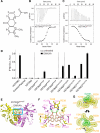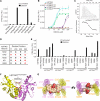Binding-pocket and lid-region substitutions render human STING sensitive to the species-specific drug DMXAA
- PMID: 25199835
- PMCID: PMC4381552
- DOI: 10.1016/j.celrep.2014.08.010
Binding-pocket and lid-region substitutions render human STING sensitive to the species-specific drug DMXAA
Abstract
The drug DMXAA (5,6-dimethylxanthenone-4-acetic acid) showed therapeutic promise against solid tumors in mouse models but subsequently failed in human clinical trials. DMXAA was later discovered to activate mouse, but not human, STING, an adaptor protein in the cyclic dinucleotide cGAMP-mediated signaling pathway, inducing type I interferon expression. To facilitate the development of compounds that target human STING, we combined structural, biophysical, and cellular assays to study mouse and human chimeric proteins and their interaction with DMXAA. We identified a single substitution (G230I) that enables a DMXAA-induced conformational transition of hSTING from an inactive "open" to an active "closed" state. We also identified a substitution within the binding pocket (Q266I) that cooperates with G230I and the previously identified S162A binding-pocket point substitution, rendering hSTING highly sensitive to DMXAA. These findings should facilitate the reciprocal engineering of DMXAA analogs that bind and stimulate wild-type hSTING and their exploitation for vaccine-adjuvant and anticancer drug development.
Copyright © 2014 The Authors. Published by Elsevier Inc. All rights reserved.
Figures




References
Publication types
MeSH terms
Substances
Associated data
- Actions
- Actions
- Actions
- Actions
Grants and funding
LinkOut - more resources
Full Text Sources
Other Literature Sources
Molecular Biology Databases
Research Materials

